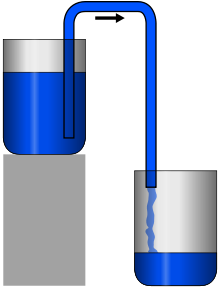

A siphon (from Ancient Greek σίφων (síphōn) 'pipe, tube'; also spelled syphon) is any of a wide variety of devices that involve the flow of liquids through tubes. In a narrower sense, the word refers particularly to a tube in an inverted "U" shape, which causes a liquid to flow upward, above the surface of a reservoir, with no pump, but powered by the fall of the liquid as it flows down the tube under the pull of gravity, then discharging at a level lower than the surface of the reservoir from which it came.
There are two leading theories about how siphons cause liquid to flow uphill, against gravity, without being pumped, and powered only by gravity. The traditional theory for centuries was that gravity pulling the liquid down on the exit side of the siphon resulted in reduced pressure at the top of the siphon. Then atmospheric pressure was able to push the liquid from the upper reservoir, up into the reduced pressure at the top of the siphon, like in a barometer or drinking straw, and then over.[1][2][3][4] However, it has been demonstrated that siphons can operate in a vacuum[4][5][6][7] and to heights exceeding the barometric height of the liquid.[4][5][8] Consequently, the cohesion tension theory of siphon operation has been advocated, where the liquid is pulled over the siphon in a way similar to the chain fountain.[9] It need not be one theory or the other that is correct, but rather both theories may be correct in different circumstances of ambient pressure. The atmospheric pressure with gravity theory cannot explain siphons in vacuum, where there is no significant atmospheric pressure. But the cohesion tension with gravity theory cannot explain CO2 gas siphons,[10] siphons working despite bubbles, and the flying droplet siphon, where gases do not exert significant pulling forces, and liquids not in contact cannot exert a cohesive tension force.
All known published theories in modern times recognize Bernoulli’s equation as a decent approximation to idealized, friction-free siphon operation.
- ^ Cite error: The named reference
Ramettewas invoked but never defined (see the help page). - ^ Cite error: The named reference
Richert Binder 2011was invoked but never defined (see the help page). - ^ Cite error: The named reference
McGuirewas invoked but never defined (see the help page). - ^ a b c Cite error: The named reference
Minor1914was invoked but never defined (see the help page). - ^ a b Boatwright, A.; Hughes, S.; Barry, J. (2015-12-02). "The height limit of a siphon". Scientific Reports. 5 (1): 16790. Bibcode:2015NatSR...516790B. doi:10.1038/srep16790. ISSN 2045-2322. PMC 4667279. PMID 26628323.
- ^ Michels, John (1902). Science. American Association for the Advancement of Science. p. 152. Retrieved 15 April 2018 – via Internet Archive.
duane siphon 1902.
- ^ Cite error: The named reference
Nokeswas invoked but never defined (see the help page). - ^ Water Flowing Up 24 meters Not Magic, Just Science! Gravity of Life (Part3) on YouTube
- ^ Amazing Slow Motion Bead Chain Experiment | Slow Mo | Earth Unplugged on YouTube.
- ^ Pouring and Siphoning a Gas on YouTube